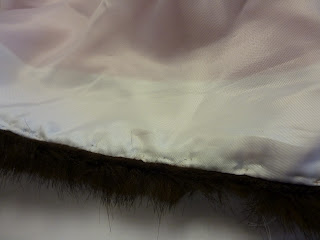Making the robes for the Mayor of Bournemouth has been a
massive learning curve for me.
I initially wanted to do this project in order to learn how
to make replica garments. I feel that in a way I have done this or I have
certainly learnt techniques that will help me in the future. I was disappointed that in the end I had to
settle on not making a replica and just making an interpretation. In hindsight I
feel it would almost be impossible to create a replica without the original
with you but I feel we have managed to make a fairly faithful interpretation.
We put a lot of time and effort into drafting the pattern
for this gown. I was surprised by just how complicated the construction was, particularly
with the sleeves and I had never seen a sleeve constructed this way before. What
I found particularly challenging when drafting was not working with a
reference. There were also elements of the gown where I was confused to why
they had done such things on the original such as fold under some velvet ribbon
on the top sleeve. This experience has made me a lot more confident in my
drafting and I now feel that after this years practice I could tackle any
design of costume.
There have been many valuable experiences such as working
with a proper client as well as learning how to cartridge pleat. I am pleased
with the pleats as a first attempt and would like to develop my technique in the
future so that the pleat are perfectly smooth.
The part of the project that I am most proud of is that we
managed to construct the robe almost independently. We didn’t rely on a tutor
for support and when faced with problems we managed to figure them out. I think
this has helped me to develop my initiative and logic when it comes to pattern
construction. I do however that this method of trial and error was slow. There
were points where I think we probably needed some support to get answer faster.
I think time was an issue on this project but I think this
in a way reflects the real world. We had problems with deliveries arriving late
and Abi was away on work experience, both of which we had to work around. Also
the Mayor was ill for our second fitting which put us behind by about a week.
These problems I think are just something you have to deal with and be flexible
around and I think we learnt quickly how to be adaptable and roll with the
punches.
I am pleased that I was able to work with a partner on this
project and Abi and I worked well together. It meant that we could bounce ideas
off one another until we solved the problems. We tried to delegate jobs so that
we worked efficiently and didn’t get in each other’s way when making the final
gown. With the toile we were keen to learn all the techniques each and so we
did most of it together and I think I can safely say that I now understand this
gown in detail. I am quite a perfectionist when it comes to finishes and I feel
we were let down a bit there. I am used to having control over the garments and
I am making whereas in this project I adjusted to sharing responsibility.
I have been trying to immerse myself in the subject by
visiting London and reading books and I think I have discovered a lot
considering that this area is so rarely written about. I love research and this
has been incredibly frustrating as I have just been searching for where the
origins of the silhouette may have come from. I really enjoyed going
to the National Art Library. It was an environment that I loved and this, along
with the lectures I’ve attended has made me more determined to carry on my
studies into postgraduate level.
I am pleased that the final robe is lightweight for summer use as
this was one of the main aspects of the brief and the Mayor was happy with it
which was essential. I would have liked to have more time for finishing the
gown to a high standard which is where I feel we let the garment down.
In the future I think I would like to work on a more
collaborative project. I think at times Abi and I felt like we hadn’t seen
anyone in days whilst we worked. In Battle for the Winds I enjoyed liaising
with people and this is something I would like to do again as I feel my
confidence has grown over this project.
.jpg)
.jpg)
















